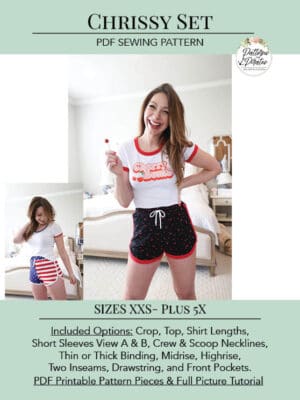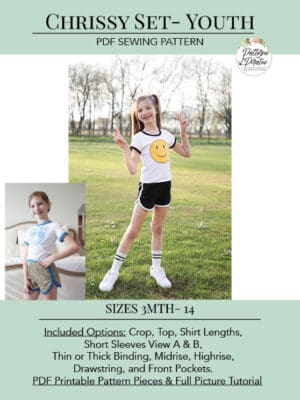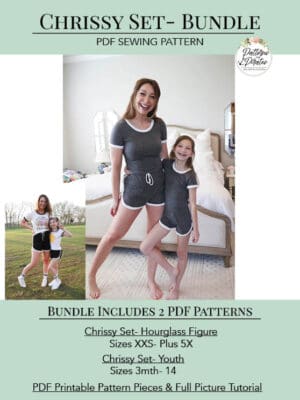I’m excited to share another hack to the new Essential Tank pattern! I’ve seen this look in the popular athletic wear brands and love it! But being 5’10” means no way I can buy it off the rack, even if I wanted to splurge on the price tag 😉
So, I hacked the newest pattern in the P4P collection and I’m so in love with the result! I used a brushed polyester blend that is super soft.
I took the front and raise the neckline by 2″ (although the inspiration tank was probably 3″ higher I just can’t take a neckline that close!). Make sure your neckline ends at a straight angle or you will have a point when you open up your folded front. If you have a french curve use it for a nice smooth neckline. If not, you can get it as smooth as possible.
Next I cut the back. Here I cut the full piece to help demonstrate, but you can skip cutting the entire piece to save on fabric.
I took my straight edge and alined it to the widest part of the racerback. I sliced it straight from the top of the shirt to the bottom hem. (I’ll mention here I did shirt length cutline. but left it unhemmed).
Then I cut another MIRROR image back piece.
I decided to leave my hem and back edges raw. If you wanted to hem, go ahead and hem those back center edges now.
Tip-I ALWAYS cut a center notch on the necklines of every shirt- they’re cut on the fold and you always need that center mark for attaching your neckband marked anyways. It is such a quick, easy time to mark it with a notch!
With both right sides up and aligning the center, baste the overlapping sections along the neckline. Looking back I would also advise to baste just outside the 3/8″ seam allowance as well to hold it in place while attaching the neckband. It’s such a small section that extra baste will really help keep it nice and neat.
Then just sew up the shirt as the tutorial recommends, treating the back as 1 back piece. If you make the neckline higher you will need to shorten your neckband a bit as well. A good ratio is about 80-85% of the finished neckband plus your seam allowance.
And wa-lah! Now you can waer it open and loose or tie it at the bottom for a more fitted look! And a big bonus (for me anyways ;)) is that you can untie the back and it’s super nursing friendly! I already have 2 more fabrics that need to become this hack! I can see myself wearing these with some capri peglegs throughout the hot TX summer! I have it paired with a cute Siren Swim Top I made for a sports bra!
Don’t forget to share your final creations in the P4P Facebook group, tag me on Instagram, or in your favorite sewing forum! <3 I absolutely love to see your P4P creations!



























































































 I sewed up my entire cardigan exactly as normal. Then tried it on both with Baby Girl on me and without and marked where I would like the cardigan to close. Of course, Little Guy had to come photobomb a few shots ;).
I sewed up my entire cardigan exactly as normal. Then tried it on both with Baby Girl on me and without and marked where I would like the cardigan to close. Of course, Little Guy had to come photobomb a few shots ;).







































 Next, I cut a small rectangle of interfacing.
Next, I cut a small rectangle of interfacing.


 Next, I marked my buttonholes. I did about 1/2″ from the center for each. I choose a smaller button so that my holes weren’t too big (I hate when I tie a drawstring and the holes gap open!).
Next, I marked my buttonholes. I did about 1/2″ from the center for each. I choose a smaller button so that my holes weren’t too big (I hate when I tie a drawstring and the holes gap open!).
 You will need to use a knit button hole. Here is what mine looks like on my machine. The zigzag sides let the knit stretch without popping the threads.
You will need to use a knit button hole. Here is what mine looks like on my machine. The zigzag sides let the knit stretch without popping the threads.
 Now just sew up your pants exactly as the pattern tutorial instructs. The only thing to consider is to make sure you’re placing your button holes correctly when attaching the waistband to the pants. After they’re all sewn up, you can put your drawstring through your button holes and around the waistband. I always use a safety pin to help guide it through.
Now just sew up your pants exactly as the pattern tutorial instructs. The only thing to consider is to make sure you’re placing your button holes correctly when attaching the waistband to the pants. After they’re all sewn up, you can put your drawstring through your button holes and around the waistband. I always use a safety pin to help guide it through.
 Tada! Now you can wear your ever so comfortable, stylish sweatpants without fear they might look like you stepped out in your pjs 😉
Tada! Now you can wear your ever so comfortable, stylish sweatpants without fear they might look like you stepped out in your pjs 😉











